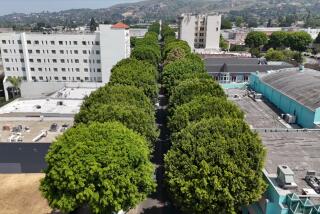Transplanting 5-Story Trees a Tall Order
CHARLOTTESVILLE, Va. — Developers of the University of Virginia’s research park are saving and transplanting 3,000 trees, some of them five stories tall, rather than cutting them and burning the debris.
The trees, 106 of which rise 50 to 60 feet, are being replanted along the mile-long main road that winds through the 532-acre research park near the Rivanna River and the Charlottesville airport.
“We had all these beautiful trees on our property, and many were going to be destroyed for development,” said Bruce Stouffer, director of research park development for the University of Virginia Foundation.
The private foundation, which manages the university’s off-campus real estate, embarked on the massive tree relocation as part of its overall plan to make the research park a model of environmentally sensitive development.
It’s a costly, time-consuming process in which about 18 workers use backhoes, bulldozers and a large crane along with the usual shovels, picks and axes. The transplanting will cost from $200,000 to $250,000, about half of the $500,000 price of landscaping the research park, Stouffer said. It will take more than a month to finish.
However, it costs about twice as much to buy a tree from a nursery as it does to replant it from the same property, Stouffer said.
There are three businesses in the new research park, but there are more than 50 building sites. The university wants to have a mix of high-tech industries, research companies and academic buildings, and it is leaving 40% of the park undeveloped.
Workers are replanting about 2,500 cedar trees and 500 hardwoods from the property. They also are planting hundreds of trees, purchased from nurseries, in parking lots that the developers call “parking orchards.”
Landscape architect Jim Brown said they are trying to replicate the existing forest pattern as they replant trees of varying sizes and species in the road median and roadsides.
The foundation hired Davey Tree Expert Co. of Kent, Ohio, which has been moving trees since 1880 and has done relocation projects for the National Arboretum in Washington, the National Park Service and Arlington National Cemetery.
Robert Craft, assistant manager of the company’s district office in Chantilly, said they’ve moved bigger trees--the largest was a white oak with a 15-foot diameter moved 10 years ago at the Arlington cemetery.
But Craft said that as far as he knows, the research park project is the largest tree relocation in the country.
As long as the trees are transplanted in the winter, when they are dormant, and the root ball is big enough, there is no difference in the survival rate of big trees and small trees--about 95%, Craft said.
The practice of relocating trees is becoming more popular, Craft said, and some local ordinances now require developers to transplant at least some of the trees.
More to Read
Sign up for Essential California
The most important California stories and recommendations in your inbox every morning.
You may occasionally receive promotional content from the Los Angeles Times.










